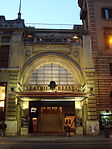Palazzo Pallavicini-Rospigliosi

The Palazzo Pallavicini-Rospigliosi is a palace in Rome, Italy. It was built by the Borghese family on the Quirinal Hill; its footprint occupies the site where the ruins of the baths of Constantine stood, whose remains still are part of the basement of the main building, the Casino dell'Aurora. Its first inhabitant was the famed art collector Cardinal Scipione Borghese, the nephew of Pope Paul V, who wanted to be housed near the large papal Palazzo Quirinale. The palace and garden of the Pallavicini-Rospigliosi were the product of the accumulated sites and were designed by Giovanni Vasanzio and Carlo Maderno in 1611–16. Scipione owned this site for less than a decade, 1610–16, and commissioned the construction and decoration of the casino and pergolata, facing the garden of Montecavallo. The Roman palace of this name should not be mistaken for the panoramic Villa Pallavicino on the shores of Lake Como in Lombardy.
Excerpt from the Wikipedia article Palazzo Pallavicini-Rospigliosi (License: CC BY-SA 3.0, Authors, Images).Palazzo Pallavicini-Rospigliosi
Via Ventiquattro Maggio, Rome Municipio Roma I
Geographical coordinates (GPS) Address External links Nearby Places Show on map
Geographical coordinates (GPS)
| Latitude | Longitude |
|---|---|
| N 41.8984 ° | E 12.4877 ° |
Address
Palazzo Rospigliosi-Pallavicini
Via Ventiquattro Maggio 43
00187 Rome, Municipio Roma I
Lazio, Italy
Open on Google Maps









